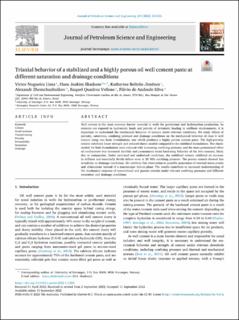| dc.contributor.author | Lima, Victor Nogueira | |
| dc.contributor.author | Skadsem, Hans Joakim | |
| dc.contributor.author | Beltrán-Jiménez, Katherine | |
| dc.contributor.author | Zhemchuzhnikov, Alexandr | |
| dc.contributor.author | Velloso, Raquel Quadros | |
| dc.contributor.author | Silva, Flavio de Andrade | |
| dc.date.accessioned | 2023-03-23T09:33:20Z | |
| dc.date.available | 2023-03-23T09:33:20Z | |
| dc.date.created | 2022-09-16T08:25:29Z | |
| dc.date.issued | 2022 | |
| dc.identifier.citation | Lima, V. N., Skadsem, H. J., Beltrán-Jiménez, K., Zhemchuzhnikov, A., Velloso, R. Q., & de Andrade Silva, F. (2022). Triaxial behavior of a stabilized and a highly porous oil well cement paste at different saturation and drainage conditions. Journal of Petroleum Science and Engineering, 219, 111055. | en_US |
| dc.identifier.issn | 0920-4105 | |
| dc.identifier.uri | https://hdl.handle.net/11250/3060055 | |
| dc.description.abstract | Well cement is the most common barrier material in wells for geothermal and hydrocarbon production. As cements are exposed to hydrostatic loads and periods of deviatoric loading in wellbore environments, it is important to understand the mechanical behavior of cement under relevant conditions. We study effects of porosity, saturation, confining pressure and drainage conditions on the mechanical behavior of class G well cement using two basic formulations, one which produces a highly porous cement paste. The high-porosity cement exhibited lower strength and reduced elastic moduli compared to the stabilized formulation. The elastic moduli for both formulations were reduced with increasing confining pressure, and the most pronounced effect of confinement was increased ductility and pronounced strain hardening behavior of the two cements, likely due to compaction. Under saturated and undrained conditions, the stabilized cement exhibited an increase in stiffness and essentially brittle failure even at 20 MPa confining pressure. The porous cement showed less sensitivity to drainage conditions. We attribute this observation to possible generation of internal micro-cracks and dislocations instead of a macroscopic failure plane. The results contribute to increased understanding of the mechanical response of conventional and porous cements under relevant confining pressures and different saturation and drainage conditions. | en_US |
| dc.language.iso | eng | en_US |
| dc.publisher | Elsevier | en_US |
| dc.rights | Navngivelse 4.0 Internasjonal | * |
| dc.rights.uri | http://creativecommons.org/licenses/by/4.0/deed.no | * |
| dc.title | Triaxial behavior of a stabilized and a highly porous oil well cement paste at different saturation and drainage conditions | en_US |
| dc.type | Peer reviewed | en_US |
| dc.type | Journal article | en_US |
| dc.description.version | publishedVersion | en_US |
| dc.rights.holder | The authors | en_US |
| dc.subject.nsi | VDP::Teknologi: 500 | en_US |
| dc.source.volume | 219 | en_US |
| dc.source.journal | Journal of Petroleum Science and Engineering | en_US |
| dc.identifier.doi | 10.1016/j.petrol.2022.111055 | |
| dc.identifier.cristin | 2052268 | |
| dc.relation.project | Norges forskningsråd: 309295 | en_US |
| cristin.ispublished | true | |
| cristin.fulltext | original | |
| cristin.qualitycode | 2 | |

